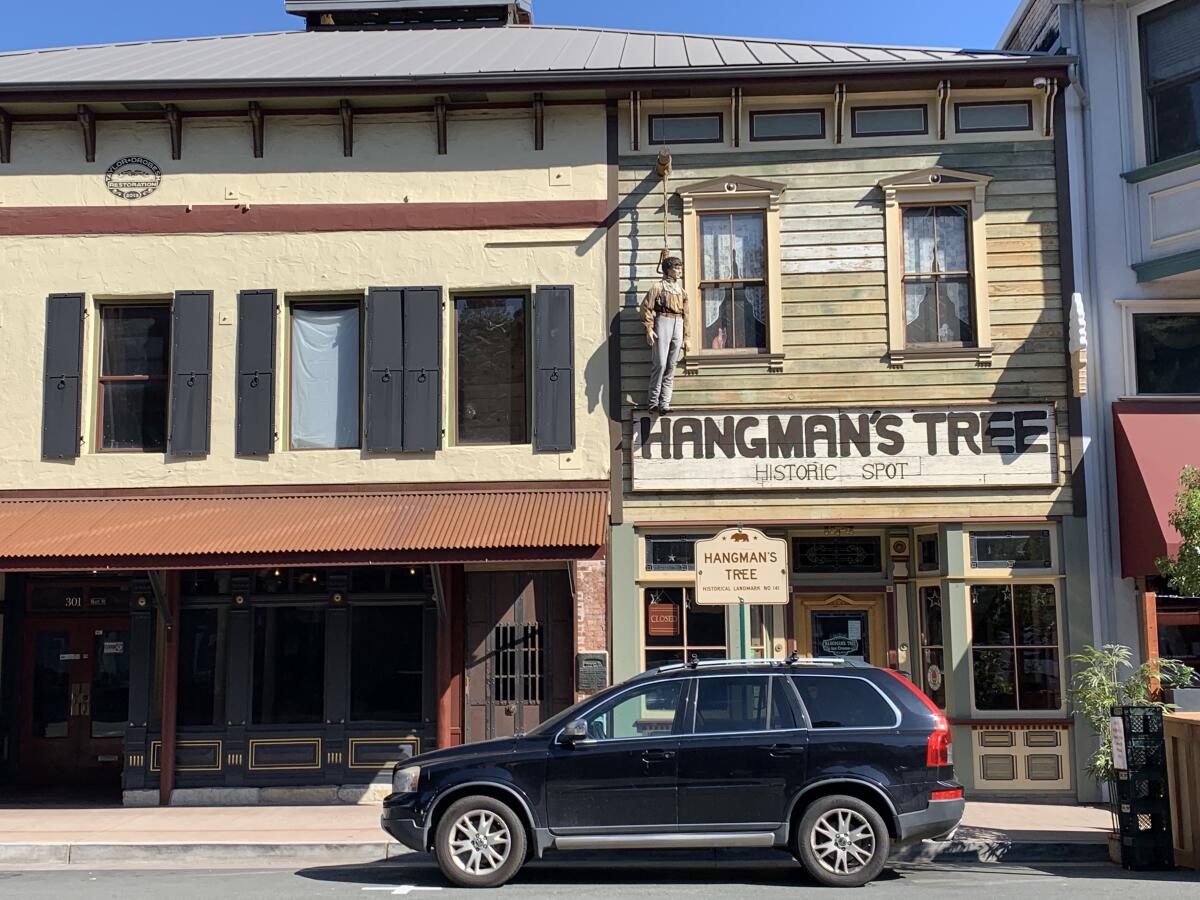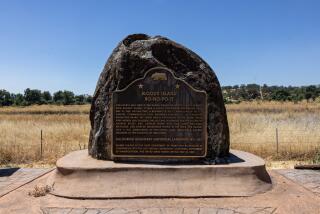Chop down the lynching tree from this California city’s logo? Probably not so fast

- Share via
PLACERVILLE — Mike Saunders talks about Placerville’s infamous “noose of justice” almost dispassionately. Even when, on one recent sweltering afternoon, he told me about unnamed people threatening to use it on him, he ended the story with a resigned shrug that almost masked the frustration in his eyes.
Such is the lot in life for a prominent, liberal-minded Black man who lives in overwhelmingly conservative and white El Dorado County. He has learned to pick his battles.
Which brings me back to the noose.
Much has been said lately about the reasons to get rid of the cartoonish piece of rope that hangs menacingly from a tree on Placerville’s official city logo. And, to a lesser extent, reasons to ditch the mannequin named George, who is strung up by his neck on the side of a downtown building, and the nickname “Old Hangtown,” which still welcomes visitors to the city on a humongous sign along Highway 50.
Far less has been said about what it will take to actually do any of this. I’m referring to the inevitable complications, compromises and consequences of trying to bring even a whiff of the widespread reckoning on race to the conservative corners of California that need it the most.
Saunders can tell you, though. And his words should serve as a warning that — even in this time of breathless public opinion polls showing widespread support for Black Lives Matter — change, still, will not happen quickly or easily.
For more than a century, there have been dust-ups over both the noose and the “Hangtown” nickname, the latter of which was adopted in the mid-1800s, when mostly white residents would frequently act as jury and executioner, stringing up mostly people of color whom they had judged to have committed crimes.
This latest one started with an online petition.
It was early June, and protests — some peaceful, some not — had erupted all over the country in the wake of the police killing of George Floyd in Minneapolis. Placerville’s business owners worried that their quaint downtown, still steeped in all things glorified Gold Rush, would be next — especially when protesters, some claiming allegiance to Black Lives Matter Sacramento, showed up for a rally at the local courthouse.
About the same time, a petition to remove “Old Hangtown” from the sign on Highway 50 was making the rounds on social media.
“This moniker glorifies and celebrates a violent and racist history,” the petition states, citing the police brutality protests as a catalyst to make changes. “Placerville needs to be progressive in making our community safe and comfortable for people of color. Everyone is welcome here. Let’s not pretend to be tone deaf.”
Saunders warned members of the El Dorado County Progressives, an influential group that he helps lead, not to share the petition on Facebook. Not if they weren’t willing to endorse it, that is.
“[But] they posted it, and it immediately got shared everywhere,” he said, shaking his head. “They know I’m an elder progressive. I’m an elected official. I’m the only Black face. It became, ‘Mike Saunders is pushing this,’ and I became the face of this movement.”
The irony is that Saunders, a politically connected retiree who has lived in the county for 17 years, doesn’t really have a beef with “Old Hangtown” as much as he does with the noose on the city seal. Call it picking one’s battles. Call it a compromise. Whatever. But the noose, he said, is being used by racists to taunt Black residents today.
It was only two years ago, after all, that Bowtie Barbershop in downtown Placerville was forced to apologize after a photo of a Colin Kaepernick doll hanging by its neck from the ceiling went viral. It had apparently been there amid other NFL memorabilia since 2016, when the former San Francisco 49ers player started kneeling during the national anthem to protest police brutality.
“I literally had no idea that I was offending people,” the barbershop’s owner told a local TV station at the time. “We have a hangman out here called ‘George’ and so, you know, with the theme of ‘Hangtown,’ I hung him.”
Without the ubiquitous presence of the noose, Saunders insists, the interpretation of the “Hangtown” nickname would be different and perhaps less potent.
Plus, he said, there’s a complicated history worth considering. For no matter what sort of Jim Crow nastiness the noose conjures up, this is California, not Mississippi. It was American Indians — along with Chinese immigrants and Mexicans — who were strung up far more often than Black people during the Gold Rush.
“Native people get left out of the conversation, even though, in this case, I feel certain they were the primary victims of mob justice or vigilantism or whatever you want to call it,” said Brendan Lindsay, a history professor at Sacramento State.
Thinking otherwise was a mistake I made the first time I wandered into Placerville, not long after moving to California from the Midwest. Seeing “George” hanging from that noose and the many murals touting “Old Hangtown,” I felt terror, then confusion and then curiosity.
“It’s not about racism,” some inebriated white dude told me at the time. “It’s about justice.”
That’s “justice,” as in “vigilante justice,” which pairs nicely with the Trump administration’s current, racist re-branding of it as “law and order.” Then as now — whether it’s an Indigenous man in what’s now Placerville, labeled by a mob jury as a thief and hanged, or a protester in Portland, labeled by federal agents as violent and grabbed from the streets — it’s the same extrajudicial punishment being unfairly meted out against Black and brown people, and white allies.
More than anything, it’s this allegiance to revisionist history — and willful blindness about the complexion of those who were lynched — that is propping up objections to removing the noose from Placerville’s city logo.
The City Council, faced with strident objections from residents eager to preserve their telling of the city’s past, postponed a decision until January on whether to yank the noose from the seal, all public buildings and paperwork. That was in mid-July, after fliers with white supremacist symbols appeared throughout downtown.
Later in the month, a separate attempt by the council to put the issue before voters as a ballot measure died almost as soon as it began.
Meanwhile, an online petition to keep the “Old Hangtown” nickname, blaming “rampant political correctness and concocted victimhood” for attempts to retire it, has gathered three times as many signatures as the original petition.

Sue Taylor, the owner of the building where “George” hangs and where, in non-coronavirus times, her daughter runs a family-friendly ice cream shop, echoed the well-worn line that all of this has nothing to do with racism. Rather, removing the “noose of justice” would be like giving in to the “anarchy” she sees in TV footage of police brutality protests from others cities.
“You have a culture that’s been here since the beginning of time,” Taylor said. “And then you feel like somebody is now invading and saying, ‘You’re racist. We want you to remove all this, and there’s a threat.’ It’s created a horrible atmosphere.”
“George,” she insisted, is never coming down. And, as she is the owner of the building, trimmed with faded siding and the words “Hangman’s Tree” in brown letters, it indeed appears that the city can’t make her, because it’s private property.
All of which has left Saunders in a tough spot.
Melinda Velasco, who helps him lead the Civil Rights Now task force, which is part of El Dorado County Progressives, wants the mannequin, the nickname and the noose on the city seal gone — now.
“Times have changed. And the people in the town don’t want to change with the times. So they’re stuck,” she said. “It’s always been this way. Therefore, it’s always gonna be this way. So it’s hard. I get it emotionally. But it’s time, and it needs to go. The dummy needs to go.”
Meanwhile, since facts often have a way of disrupting a good narrative, on both the left and the right, talk of protests in Placerville has continued, mostly in the name of Black lives. Some say there’s talk of trying to form an El Dorado County chapter of Black Lives Matter.
Vanessa Esquivido, an assistant professor of American Indian Studies at Chico State, is grateful for Black activists, who are the only reason a discussion about that “damn noose” is happening at all. But she’s not happy that the racism and brutality that her ancestors endured during the Gold Rush are once again largely being glossed over.
“That history is not talked about at all here in California,” Esquivido said. “I mean, it just makes me mad.”
Saunders, the Black man forever stuck in the middle, is convinced the only way forward is to have a series of community conversations. It’s certainly not the radical choice, but it is the only one, he says, that will help the people of Placerville understand exactly why the noose needs to come down and exactly how it makes the Black and brown people of El Dorado County feel.
“I mean, people can go out on the street, and that’s all fine. That’s one part of it. You need protests, you need community action.” But, he added, Velasco looking on from his right and Taylor on his left on that sweltering afternoon, “how can we work on this together?”
More to Read
Sign up for Essential California
The most important California stories and recommendations in your inbox every morning.
You may occasionally receive promotional content from the Los Angeles Times.














